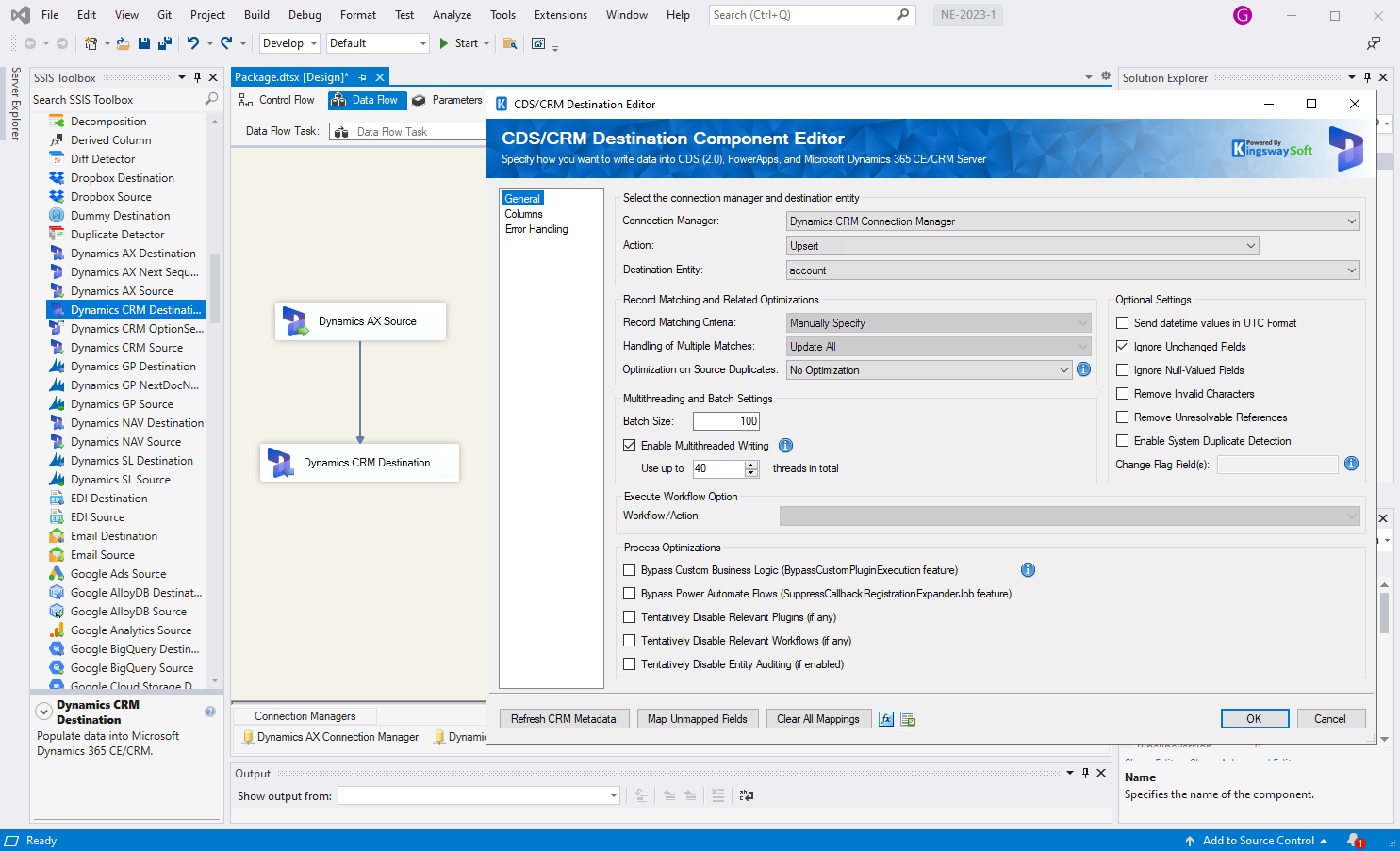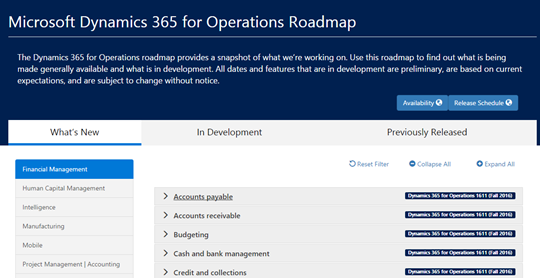SysOperation Framework In Dynamics 365 for Operations The SysOperation Framework, initially called Business Operation Framework, seem to be the new substitute of the RunBase framework. As such, it allows you to perform operations that require parameters from the user, it allows you to set the operations to be executed in batch, or in a new.
$f = Get-ChildItem C:tempAll81BinaryUpdates_4_4.zip #Please update this path
#############################################
$ErrorActionPreference ='Stop'
#region Installing d365fo.tools and dbatools <--
# This is requried by Find-Module, by doing it beforehand we remove some warning messages
Write-Host 'Installing PowerShell modules d365fo.tools and dbatools'-ForegroundColor Yellow
Install-PackageProvider -Name NuGet -MinimumVersion 2.8.5.201 -Force -Scope AllUsers
Set-PSRepository -Name PSGallery -InstallationPolicy Trusted
$modules2Install =@('d365fo.tools')
foreach($module in $modules2Install)
{
Write-Host '.working on module' $module -ForegroundColor Yellow
if ($null -eq $(Get-Command -Module $module)){
Write-Host '..installing module' $module -ForegroundColor Gray
Install-Module -Name $module -SkipPublisherCheck -Scope AllUsers
} else {
Write-Host '..updating module' $module -ForegroundColor Gray
Update-Module -Name $module
}
}
#endregion Installing d365fo.tools and dbatools -->
#region Stop D365FO instance
Write-Host 'Stopping D365FO environment'-ForegroundColor Yellow
Stop-D365Environment | FT
#endregion Stop D365FO instance
#region Test Deployable package
if (-not (Test-Path -Path $f.FullName))
{
Write-Warning 'File $($f.FullName) can not be found. Please check `$f variable'
throw 'File $($f.FullName) can not be found. Please check `$f variable'
}
#endregion Test Deployable package
#region Old Runbooks -->
if ($null -ne $(Get-D365Runbook))
{
Write-Host 'Old runbooks has been found. Backup and remove'
Get-D365Runbook | Backup-D365Runbook -Force -Verbose #Delete old runbooks
(Get-D365Runbook).File | Remove-Item -Force
} else {
Write-host 'No old runbooks has been found'
}
#endregion Old Runbooks -->
#region Deploy Deployable package
## it will be extracted from Archive and Deployed
Invoke-D365SDPInstall -Path $f.FullName -Command RunAll -Verbose
## Example How to re-execute failed step
# $extractedDP = Join-Path -Path $f.Directory -ChildPath $f.BaseName
# If (-not (Test-Path -Path $extractedDP)) { throw 'Please update `$extractedDP variable with correct path with extracted Deployable Package' }
# Invoke-D365SDPInstall -Path $extractedDP -Command ReRunStep -Step 25 -ShowOriginalProgress -Verbose
#endregion Deploy Deployable package
- Dynamics AX has been rebranded Dynamics 365 for Finance and Operations, On-Premises. Take the next steps to learn how a modern, intelligent ERP solution can help you grow your business.
- Dynamics AX to Dynamics 365: Upgrade Preparation November 27, 2019 Dynamics 365 Migration: 5 Reasons to have your head in The Cloud February 17, 2021 Dynamics 365 Resolutions for the New Year January 7, 2021.
- Microsoft Dynamics AX Dynamics AX is a powerful enterprise resource planning (ERP) software package for finance and operations. It helps global enterprises organize, automate, and optimize their processes on-premises, in the cloud, or through hybrid deployment. It’s part of the Microsoft Dynamics suite of intelligent business applications.
- Fully Integrated with MS Dynamics 365 for Finance and Operations A true and easy-to-use plug-in will make your report customization fast and easy. Supports D365FO, AX 2012 R2/R3. Lightweight, without external services.
Applies To: Microsoft Dynamics AX 2012 R3

This article explains how to use the features and services that are included in Power BI for Office 365 to access, explore, and gain insight from your Microsoft Dynamics AX data.
Overview of Power BI for Office 365 How Microsoft Dynamics AX integrates with Power BI for Office 365 |
Overview of Power BI for Office 365
Microsoft Power BI for Office 365 is a collection of features and services that, together, enable you to visualize data, share discoveries, and collaborate in new ways. Familiar tools including Excel and SharePoint form the foundation of Power BI. The value of Power BI is how its features and services work together, and how the insights are securely, yet interactively shared.
Access data with Excel
The features listed in the following table are part of the familiar Excel environment. Reality steve twitter spoilers. These features enable you to access data and display that data in interactive charts, graphs, and maps. Some of these features have been available before, some are new, but each is now integrated into Excel and into Power BI online services.
Feature | Description |
|---|---|
Use Power Query to access data from public and corporate data sources. Power Query includes a new online search feature that helps you find public data on the Web. | |
Use Power Pivot to create analytical models in the familiar Excel environment. You can mash-up data from multiple sources and analyze large amounts of data. | |
Use Power View to create interactive charts and graphs that help you explore and present your data visually in Excel. | |
Use Power Map to explore and navigate data on a 3D map in Excel. |


Ax Microsoft Dynamics
Collaborate in Office 365
Dynamics Ax 365
The features listed in the following table help you share data and reports with team members who are anywhere in the world.
Ax 365 Development
Feature | Description |
|---|---|
Create collaborative Power BI sites for your team to share and view reports. Larger workbook viewing is also supported so that users can view and interact with larger workbooks through the browser. | |
Type your questions into the Q&A speech bubble for immediate answers in the form of interactive charts and graphs. | |
Access the latest reports posted to your Power BI site from an app on your mobile device. |
How Microsoft Dynamics AX integrates with Power BI for Office 365
The following diagram shows how you can use the features of Power BI for Office 365 to access, explore, and gain insight from your Microsoft Dynamics AX data.

Plan
The first step in this process is to determine what data to display on your reports. For example, you’ll want to consider the following questions:
What is the business problem you’re trying to solve?
What data can provide insight into this issue?
After you’ve figured out what data you want to display on your reports, determine what data sources you’ll use to access that data. You can use the following types of Microsoft Dynamics AX data sources:
OData feeds
SQL Server Analysis Services cubes
List pages
You may also want to mash-up your data with other sources for deeper analysis. For example, you may want to mash-up your Microsoft Dynamics AX data with data from the Web. If so, identify those data sources, as well.
Build
After you’ve figured out what data sources you’ll use, you can build your reports and analyze data. The following articles provide examples of how to do this:
Share Explorer 9 for mac os x download.
To share reports with others in your organization, see the following articles:
To display a report on a Role Center page in Enterprise Portal, see the “Display the report on a Role Center page” section of Create a report by using Power View to connect to a cube.
To display a report in a Power BI site for Office 365, see Power BI sites on Power BI for Office 365.
To display a report in the Power BI app, see the “View your own reports in the Powe BI app” section of Power BI Windows Store app help.

